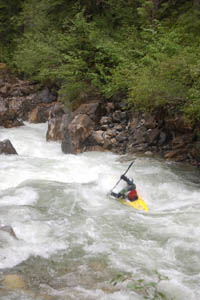 The Okanogan and Wenatchee National Forests encompass over 4 million acres and are managed as one forest with headquarters in Wenatchee, Washington. The rivers on this Forest are very important to the whitewater paddling community both as a close-to-home destination for residents of Washington State and as a popular objective for paddling road trips for paddlers from across the country. During the spring snow melt, the rivers flow fast and cold but the days are long and the dry sunny weather of Eastern Washington is ideal for living out of your rig and using a bike shuttle to take in the great whitewater the region offers.
The Okanogan and Wenatchee National Forests encompass over 4 million acres and are managed as one forest with headquarters in Wenatchee, Washington. The rivers on this Forest are very important to the whitewater paddling community both as a close-to-home destination for residents of Washington State and as a popular objective for paddling road trips for paddlers from across the country. During the spring snow melt, the rivers flow fast and cold but the days are long and the dry sunny weather of Eastern Washington is ideal for living out of your rig and using a bike shuttle to take in the great whitewater the region offers.
American Whitewater's priorities are conservation of the rivers and the surrounding forest through wilderness protection of headwaters, designation of river corridors under the Wild and Scenic Rivers Act, and policies that encourage adequate funding of recreation sites and roads providing access used by paddlers, climbers, mountain bikers, and hikers.
Wenatchee, Okanogan, and Colville National Forest Planning
The Forest Service is developing a new Forest Plan for these forests that will guide management for the next decade or more. The last plan was in 1990. Of interest to river advocates, these plans evaluate rivers for Wild and Scenic designation. Once a river is determined to be suitable for designation it is managed to protect its free-flowing nature until Congress has an opportunity to take action.
In its previous 1990 plan the Forest Service determined that the Little Wenatchee, Rattlesnake Creek, Tieton, Naches, and Cooper were not suitable for Wild and Scenic designation. They found that these rivers did not have outstanding remarkable values of regional or national significance. These rivers are obviously significant resources for the whitewater community and with the increase in creek boating since 1990, the Forest Service needs to reevaluate these rivers.
In the 1990 Forest Plan the following rivers were deemed eligible and suitable for Wild and Scenic designation:
- American
- Chiwawa
- Cle Elum
- Entiat
- Icicle Creek
- Napeequa
- Waptus
- Wenatachee
- White
The following rivers were deemed ineligible or not suitable:
- Bumping
- Cooper
- Kachess
- Little Naches
- Little Wenatchee
- Mad
- Naches
- North Fork Entiat
- Teanaway
- Tieton
- Rattlesnake Creek
American Whitewater is working to see this list of rivers reevaluated as part of the new Forest Plan. To be eligible for designation, a river must be free-flowing and possess one or more Outstandingly Remarkable Values (ORV): these values can include scenery, recreation, geology, fish, wildlife, prehistory, history, or other values (e.g. hydrology, paleontology, botany, etc.) At least one of these must be an ORV for the river to be Wild and Scenic.
As outlined in Forest Service handbook, the key point is that “in order to be assessed as outstandingly remarkable, a river-related value must be a unique, rare, or exemplary feature that is significant at a comparative regional or national scale.” Specifically the value must represent a “conspicuous example from among a number of similar values that are themselves uncommon or extraordinary.”
For recreation, “opportunities the river provides are, or have the potential to be, popular enough to attract visitors from throughout or beyond the region of comparison or are unique or rare within the region. Visitors are willing to travel long distances to use the river resources for recreational purposes.”
If you are writing comments to the agency, keep these points in mind for what merits an “Outstanding Remarkable Value” and in particular any changes that have occurred since 1990. One obvious change is the development of creek boating (particularly relevant to the Cooper and Little Wenatchee).
